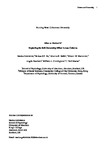Mine or mother’s? Exploring the self-ownership effect across cultures
| dc.contributor.author | Golubickis, Marius | |
| dc.contributor.author | Ho, Nerissa | |
| dc.contributor.author | Falbén, JK | |
| dc.contributor.author | Mackenzie, KM | |
| dc.contributor.author | Boschetti, A | |
| dc.contributor.author | Cunningham, WA | |
| dc.contributor.author | Neil Macrae, C | |
| dc.date.accessioned | 2020-04-07T10:35:18Z | |
| dc.date.available | 2020-04-07T10:35:18Z | |
| dc.date.issued | 2019-06 | |
| dc.identifier.issn | 2193-8652 | |
| dc.identifier.issn | 2193-8660 | |
| dc.identifier.uri | http://hdl.handle.net/10026.1/15521 | |
| dc.description.abstract |
In exploring self-biases in cognition and decision-making, recent research has demonstrated cultural variation in the emergence of the self-ownership effect in memory. Whereas Westerners display enhanced memory for items owned by the self (vs. mother), this effect is reversed among Asian participants. Developing this line of inquiry, here we considered whether cultural influences on ownership extend to other outcomes—specifically, the efficiency of object categorization. In two experiments, Western and Asian participants were required to report if previously assigned items (i.e., pencils and pens) were owned-by-self or owned-by-mother. Results revealed a self-prioritization effect for participants from both cultures, such that responses were faster to self-owned than mother-owned objects. To establish the origin of this effect, the processes underlying task performance were interrogated using a hierarchical drift diffusion model approach. Results of these analyses revealed that the self-ownership effect was underpinned primarily by a pre-decisional bias (i.e., starting point of evidence accumulation). These findings elucidate the extent and origin of the self-ownership effect during object processing. | |
| dc.format.extent | 1-25 | |
| dc.language | en | |
| dc.language.iso | en | |
| dc.publisher | Springer Science and Business Media LLC | |
| dc.subject | Clinical Research | |
| dc.subject | Mental health | |
| dc.title | Mine or mother’s? Exploring the self-ownership effect across cultures | |
| dc.type | journal-article | |
| plymouth.issue | 1 | |
| plymouth.volume | 7 | |
| plymouth.publication-status | Published | |
| plymouth.journal | Culture and Brain | |
| dc.identifier.doi | 10.1007/s40167-018-0068-0 | |
| plymouth.organisational-group | /Plymouth | |
| plymouth.organisational-group | /Plymouth/Faculty of Health | |
| plymouth.organisational-group | /Plymouth/Faculty of Health/School of Psychology | |
| plymouth.organisational-group | /Plymouth/REF 2021 Researchers by UoA | |
| plymouth.organisational-group | /Plymouth/REF 2021 Researchers by UoA/UoA04 Psychology, Psychiatry and Neuroscience | |
| plymouth.organisational-group | /Plymouth/REF 2021 Researchers by UoA/UoA04 Psychology, Psychiatry and Neuroscience/UoA04 Psychology, Psychiatry and Neuroscience MANUAL | |
| plymouth.organisational-group | /Plymouth/Users by role | |
| plymouth.organisational-group | /Plymouth/Users by role/Academics | |
| dcterms.dateAccepted | 2018-06-23 | |
| dc.identifier.eissn | 2193-8660 | |
| dc.rights.embargoperiod | Not known | |
| rioxxterms.versionofrecord | 10.1007/s40167-018-0068-0 | |
| rioxxterms.licenseref.uri | http://www.rioxx.net/licenses/all-rights-reserved | |
| rioxxterms.type | Journal Article/Review |


